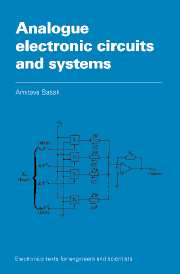6 - Modulation in communication systems
Published online by Cambridge University Press: 05 June 2012
Summary
Objectives
At the end of the study of this chapter students should be:
familiar with radio frequency carrier waves and low frequency information signals
familiar with the principles of different types of modulation
able to choose a suitable method of modulation for transmission of a particular signal.
In a communication system radio frequencies are used to carry information which is most often of low frequencies from one place to another mainly because of the ease with which the high frequency waves can propagate around the world by multiple reflections from the ionosphere and at very high frequencies antennae of modest size can form narrow beams. Ranging from roughly 3 kHz to 300 GHz radio frequencies are widely used in telephone systems, radio and television broadcasting, satellite communications and also in radio detection and ranging. Usually the information is at audio frequency and is transposed onto the radio frequency to be carried from one point to another. The process of transposition is known as modulation. There are several ways to modulate a radio wave. In this chapter we will discuss different types of modulators and also demodulators. The latter are used to recover information from modulated waves at the receiving point.
Amplitude modulation
In this type of commonly used modulator a sinusoidal carrier wave is made to vary in amplitude in sympathy with the magnitude of the low frequency information signal.
- Type
- Chapter
- Information
- Analogue Electronic Circuits and Systems , pp. 192 - 209Publisher: Cambridge University PressPrint publication year: 1991



